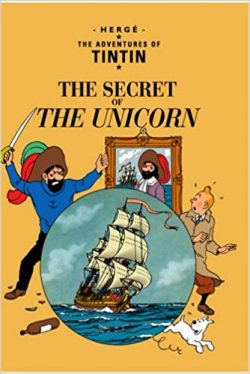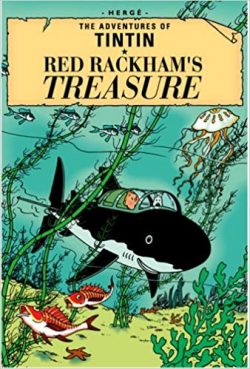

By Hergé & various; translated by Leslie Lonsdale-Cooper & Michael Turner (Egmont)
ISBN: 978-1-40520-810-9 (HB Unicorn) 978-1-40520-622-8 (PB Unicorn)
ISBN: 978-1-40520-811-6 (HB Rackham) 978-1-40520-623-5 (PB Rackham)
Georges Prosper Remi РAKA Herg̩ Рcreated a true masterpiece of graphic literature with his astounding yarns tales of a plucky boy reporter and his entourage of iconic associates. Singly, and later with assistants including Edgar P. Jacobs, Bob de Moor and the Herg̩ Studio, Remi completed 23 splendid volumes (originally produced in brief instalments for a variety of periodicals) that have grown beyond their popular culture roots and attained the status of High Art.
It’s only fair, though, to ascribe a substantial proportion of credit to the many translators whose diligent contributions have enabled the series to be understood and beloved in 38 languages. The subtle, canny, witty and slyly funny English versions are the work of Leslie Lonsdale-Cooper & Michael Turner.
On leaving school in 1925, Remi worked for Catholic newspaper Le Vingti̩me Si̩cle where he fell under the influence of its Svengali-like editor Abbot Norbert Wallez. The following year, the young artist Рa passionate and dedicated boy scout produced his first series: The Adventures of Totor for monthly Boy Scouts of Belgium magazine.
By 1928 Remi was in charge of producing the contents of the parent paper’s children’s weekly supplement Le Petit Vingtiéme and unhappily illustrating The Adventures of Flup, Nénesse, Poussette and Cochonette when Abbot Wallez urged the artist to create an adventure series. Perhaps a young reporter who would travel the world, doing good whilst displaying solid Catholic values and virtues?
And also, perhaps, highlight and expose some the Faith’s greatest enemies and threats…?
Having recently discovered the word balloon in imported newspaper strips, Remi decided to incorporate this simple yet effective innovation into his own work. He would produce a strip both modernistic and action-packed.
Beginning in early January 1929, Tintin in the Land of the Soviets appeared in weekly instalments, running until May 8th 1930. Accompanied by his garrulous dog Milou (Snowy to us Brits), the clean-cut, no-nonsense boy-hero – a combination of Ideal Good Scout and Remi’s own brother Paul (a soldier in the Belgian Army) – would report back all the inequities of the world, since the strip’s prime conceit was that Tintin was an actual foreign correspondent for Le Petit Vingtiéme…
The odyssey was a huge success, assuring further – albeit less politically-charged and controversial – exploits to follow. At least that was the plan…
During the Nazi Occupation of Belgium, Le Petit Vingtiéme was closed down and Hergé was compelled to move the popular strip to the occupiers’ preferred daily newspaper Le Soir. He diligently continued producing stories for the duration, but in the period following Belgium’s liberation was accused of being a collaborator and even a Nazi sympathiser.
It took the intervention of Resistance hero Raymond Leblanc to dispel the cloud over Herg̩, which he did by simply vouching for the cartoonist and by providing the cash to create a new magazine РLe Journal de Tintin Рwhich Leblanc published and managed. The anthology comic swiftly achieved a weekly circulation in the hundreds of thousands.
These adventures come from the Golden Age of an iconic creator’s work. Despite being produced whilst Belgium was under the control of Nazi Occupation Forces during World War II, the qualitative leap in all aspects of Hergé’s creativity is potent and remarkable.
After his homeland fell to the invaders in 1940, Georges Remi’s brief military career was over. He was a reserve Lieutenant, working on The Land of Black Gold when called up, but the collapse of Belgium meant that he was back at his drawing board before year’s end, albeit working for a new paper on a brand-new adventure. He would not return to Black Gold, with its highly anti-fascistic subtext, until 1949.
Le Secret de La Licorne ran from June 11th 1942 to January 14th 1943: a rip-roaring adventure mystery of light-hearted, escapist thrills, to create a haven of delight from the daily horrors of everyday life. It and its continuation remain a legacy of joyous adventure to this day. It’s also the first co-created with cartoonist, journalist and full-time ghost writer Jacques Van Melkebeke (AKA George Jacquet) who silently collaborated on Blake & Mortimer, Hassan et Kaddour, Corentin, Les Farces de l’Empereur and many others.
On completion it was collected as a full-colour book in 1943, re-mastered in 1946 and serialised in French newspaper Coeurs Vaillants from Mach 19th 1944.
After the dramatic and fanciful far-fetched exploits of The Shooting Star, Hergé returned to less fantastical fare with The Secret of the Unicorn which begins as Tintin buys an antique model galleon at a street market. He intends presenting it to Captain Haddock, but even before he can pay for it an increasingly desperate number of people try to buy, and even steal it from him.
Resisting all efforts and entreaties, he tells his effulgent friend of the purchase, ‘though not that a minor accident has broken one of the masts. The Captain is flabbergasted to hear of the model! He has a portrait of his ancestor Sir Francis Haddock, painted in the reign of King Charles II, in which the exact same ship features!
On returning home Tintin finds the model has been stolen, but on visiting the first and most strident of the collectors who tried to buy it from him finds that the man already has an exact duplicate of the missing model.
After much hurly-burly Tintin and Haddock discover that Sir Francis was once a prisoner of infamous pirate Red Rackham, but escaped with the location of the villain’s treasure horde. Subsequently making three models of his vessel “The Unicornâ€, the sea dog placed part of a map in each and gave them to his three sons…
Someone else obviously has divined the secret of the ships and that mysterious mastermind becomes ever more devious and ruthless in his attempts to obtain the complete map. Events come to a head when Tintin is kidnapped, which is a big mistake, as the intrepid lad brilliantly turns the tables on his abductors and solves the mystery. With the adventure suitably concluded, the volume ends with our heroes ready to embark on the no-doubt perilous voyage to recover Red Rackham’s Treasure…
For which we must turn to the next volume in this glorious repackaging of one of the World’s greatest comic strip treasures… Hergé’s Adventures of Tintin!
The Secret of the Unicorn: artwork © 1946, 1974 Editions Casterman, Paris & Tournai.
Text © 1959 Egmont UK Limited. All Rights Reserved.
The concluding tome of an epic saga, Le Trésor de Rackham le Rouge ran in Le Soir from February 9th to September 23rd 1943 and topped that thrilling mystery chase to secure three sections of a pirate map with a glorious all-out, all-action romp in search of the loot itself. During that period the artist met Edgar P. Jacobs, who became his assistant on the daily strip…
Tintin and Haddock are quietly assembling the requirements for their proposed treasure hunt. However, when a loose-lipped sailor is overheard by an enterprising reporter, the endeavour becomes a cause celebré with a horde of opportunists claiming descent from Red Rackham.
A more persistent but innocently intentioned distraction is a deaf and daffy Professor named Cuthbert Calculus who wants to use the expedition to test his new invention. He continually accosts Tintin and Haddock. Although his offer is rejected the Professor is not a man to be easily dissuaded. Mostly because he can’t hear the word “no†– or any others…
With the detectives Thompson and Thomson aboard (in case of criminal activity) the small team sets sail on their grand adventure…
This is a rich and absorbing yarn in the classic manner, full of exotic islands, nautical drama, mystery and travail, brilliantly timed comedy pieces and even a surprise ending. The restrictions of Belgium’s occupation necessitated Hergé’s curtailment of political commentary and satire in his work, but it apparently freed his Sense of Wonder to explore classic adventure themes with spectacular and memorable results. Although not the greatest of stand-alone Tintin tales, in conjunction with The Secret of the Unicorn this story becomes one of the best action sagas in the entire Hergé canon.
These ripping yarns for all ages are an unparalleled highpoint in the history of graphic narrative. Their unflagging popularity proves them to be a worthy addition to the list of world classics of literature, and stories you and your entire clan should know.
Red Rackham’s Treasure: artwork © 1945, 1973 Editions Casterman, Paris & Tournai.
Text © 1975 Egmont UK Limited. All Rights Reserved.
